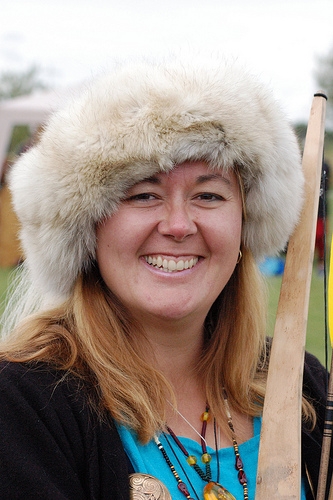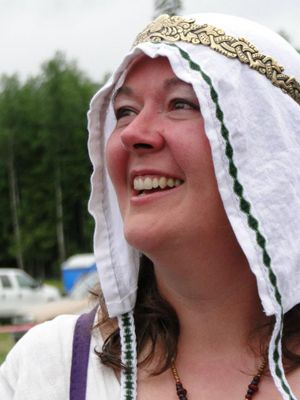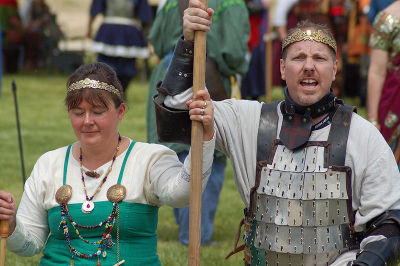Bryjna Lovisdottir of Axewater


Awards and History
- Golden Flame (Avacal)
By: Steinn Vikingsson, Gemma Meena of Cur Elmo's Keep Jul 28, 2007 (AS XLII)
By: Beothuk of the Beothuks, Wilma the Still Jul 28, 2007 (AS XLII)
- Champion of A&S, Montengarde at Montengarde's 12th Night, AS 43 / 2008
- Apprentice to Sadb Ingen Thuathail

- Award of Arms (An Tir) at Montengarde's 12th Night
By: Cedric Blackwell Rolfsson, Elizabeth Yvonne Owles Jan 19, 2008 (AS XLII)
- Rose Petal (Montengarde)
By: Beothuk of the Beothuks, Wilma the Still Jan 19, 2008 (AS XLII)
- Jambe de Lion (An Tir) at Avacal August Investiture
By: Owain ap Einar, Adwen Wrenn Aug 16, 2008 (AS XLIII)
- Forget-me-not (An Tir)
By: Adwen Wrenn Nov 29, 2008 (AS XLIII)
- King's Favor (An Tir)
By: Owain ap Einar Nov 29, 2008 (AS XLIII)
- Award of Arms (Avacal)
By: Toryn Davinsson, Natal'ia Volkovicha Nov 29, 2008 (AS XLIII)
- Throne Favor (Avacal) at February Investiture
By: Steinn Vikingsson, Gemma Delaroche Feb 27, 2010 (AS XLIV)
- King's Favor (An Tir)
By: Owain ap Einar June 5, 2010 (AS XLIV)
29th Prnicess of Avacal, by the hand of her Husband Kirk Einarsson at Avacal June Coronet Tournament XLV/2010, invested at Quad War/Investiture July 31, 2010
Persona
My name is Brynný Loðinsdóttir of Axewater.

In this photo, I am wearing a linen underdress or gown, as well as a linen Hangaroc. The Hangaroc is the green apron dress you see in this photo – normally it would be of wool, but I chose to wear a linen one on this day. The underdress/gown has sleeves embroidered with silk with an image of Thor’s horse, Sleipnir although you can’t see it in this picture. Silk was not normally worn as a garment in my time period due to its cost, but rather used as embellishment to show wealth. Cotton is also not easily available to my persona, so I make a conscious effort to use linen. Normally, to portray a woman of my wealth, I would wear another dress, or smock, under the underdress, as well as a Caftan or coat over these layers. However, the weather was very warm that day, and I chose to forgo the extra layers.
I am wearing a circlet on my head, rather than a fillet (a fabric band to hold my coif in place, which I also chose to not wear due to the heat), because in our group, I have attained the rank of Vicountess. What that means, is that my husband, the gentleman in this photo, won the right to sit the Thrones of Avacal in 2010. After we stepped down as Prince and Princess Avacal, we were granted the title of Vicount and Viscountess. The circlets are not as elaborate as many others, because this would not have fit well with our personas, where a smaller, more subtle circlet does. If you look closely, his circlet has Angry Boars in a Pictish style, while mine have Angry Sheep in a Pictish style.
I am wearing brooches pinned to my hangaroc at the straps. These brooches are circular, rather than oval, simply due to my personal preference. Woman in my time period wore either round ones, or oval. These are made of bronze, rather than silver, simply due to cost. Someday I hope to replace these with silver ones, in a design that is more period for my persona. Hanging from these brooches are several festoons. These are made of glass beads, some of which were gifts from friends, others were bought over the years. Hanging from the left brooch you can see a small bird bone, in which I store some needles in wool. Woman in my time period would normally have other things, such as scissors or small bags hanging from their brooches. Unfortunately, I broke the strand of beads my scissors and ear spoon were on, and have not repaired it at the time the photo was taken.
The necklace I wear has two pendants hanging from it. One is a Jambe de Lion, another is a Goutte de Sang. The Goutte de Sang is more visible, as it has a red bead hanging from the centre of the medallion. These represent the fact I have received an Kingdom of AnTir award for Arts and Sciences (the Jambe de Lion, which looks like a lions paw), and a Kingdom of AnTir award for Service (the Goutte de Sang). Although the rings I wear are modern, finger rings are very period, found in several of the wealthier burials in Birka.
My husband wears armour to show his wealth. He has metal lamalar plates, woven together and laced to a solid back plate. These were found in Birka in several of the male burials. He too wears a linen tunic and a circlet on his head to show he is a Viscount. He was recently made a Knight, and is now known as Thegn (pronounced Thane) Sir Kirk Einarsson.
My persona is from an area in Sweden known as Birka. It was heavily populated from approximately 750 AD to 1000 AD. During this time it was used as a trading port, and was a very important place. People from all around the world came to trade here, as evidenced by both the finding of coins as well as burials.
My persona was born close to Birka, and I have come to live here as my husband is a very wealthy trader. He has brought me many fine things from all over the world, trading when he wasn’t able to obtain it by other means. We own a large plot of land granted to us by King Olof, many ships, and have many Thralls and much wealth. Many Karls look to us for leadership, as we do to our King. My husband, Thegn Sir Kirk Einarsson is to go to the Ting in Uppsala soon, to resolve several issues that have come up recently. He has spoken with the traveler Ansgar regarding the new religion, Christianity, and he goes to speak the word of the people in this matter.
We eat 2 meals a day, one in the morning, one in the evening. Our menu would be at home in any modern person’s kitchen. Ale, beer and mead, along with milk, wine and water are our preferred drinks. We eat beef including wild bull and oxen; pork in several forms, although we don’t eat ham we do eat bacon; mutton; goat; geese; and several types of wild poultry as well as their eggs. In Birka, we eat wild poultry rather than chicken and their eggs. Wild birds survive our climate better and they don’t require any caretaking.
We have a selection of wild game to eat, including 2 different types of deer, elk, hare, bear and squirrel. We eat several different fish including herrings (salted preferred), salmon, cod, haddock, mackerel and smelt. We don’t eat as much shellfish as you might think, as it takes more effort to harvest than fish from the ocean.
We eat a large amount of grains, including barley, oats, wheat and rye which we make our bread and beer from. Honey is our only sweetener. As to vegetables, we eat leeks, beets, edible seaweed (dulse), watercress, peas, cabbage, carrots, turnips, onions, celery, fennel, radishes, endive, an edible grass modernly known as scurvy grass (it is high in Vitamin C), and rose hips (also high in Vitamin C). We eat several different nuts, including hazelnuts (these grew wild), as well as several imported nuts such as acorns, walnuts, chestnuts, and almonds.
Our food is no less flavourful than modern food, however the combinations may be strange to modern taste buds. We have salt and pepper, cumin, cardamom, cinnamon, cloves, horseradish, mustard, poppy seed, dill, parsley, thyme, mint, marjoram, wild caraway, juniper berries, garlic, lovage, saffron, grains of paradise, nutmeg, mace, anise-seed and bay leaves. Several of these are imported, but since we are able to travel to distant lands, this is not an issue. We also have vinegar, however it isn’t used to pickle things, but rather to flavour food.
We eat a large selection of fruit, including plums, cherries, blackberries, elderberries, raspberries, strawberries, and rowanberries. There are places within the Norse culture that eat apples and crab apples, unfortunately, Birka is not one of them.
We have milk to drink and to make skyr from. Skyr is a cultured yoghurt type dish. We save the leftover liquid to help preserve our meats. We eat butter and cheeses. These are firmer cheeses, such as an Edam or Jarlsberg type, rather than a softer cheese such as brie. Harder cheeses last longer and are easier to store as well.
In our spare time, the people on our farms play Tafl games. In modern times, this is known as Kings Table. We also play dice games, and have had several games introduced to us by all the travellers who come to Birka. Usually we play more often in the winter, when sometimes we are all inside for days at a time. In the summer, we try to go outside as much as possible. The boys have a tendency to play more wrestling games, but I don’t like them very much as I have seen people get very hurt playing them. The boy children also practice with their swords, and both the girls and boys practice with their bow and arrows.
I am a spinner and weaver, as are all the women and girl children on our farms. We weave all our own clothes, which starts early in the year at shearing time. The men help out by carding all the wool, so that the women can spin it, so the younger children can ply the wool. I enjoy weaving on my warp weighted loom, and am very practiced at the broken diamond twill which is well known in Birka. We have had people import extremely fine wool from the east, and have mastered their techniques here at home. We no longer need to spend so much to receive so little, but can make our own fine woven fabric.
Most of the clothing here in Birka have been dyed a blue with Woad. I know in other places they like red from Madder. I have also heard of a purple fabric that was obtained from a shellfish that is worth it’s weight in gold. Although we are very wealthy, I don’t think I would want to wear fabric like that. I enjoy the beautiful blues we get from the Woad grown in our gardens.
Heraldry and Name
Registered by the College of Herald, April 2010, as Brynný Loðinsdóttir of Axewater. Device can be found on the An Tir Roll of Arms
Other Activities
During the summer you can find me at some camping event. In the winter you might find me at my sewing machine, or my loom. I am interested in Quilting, Sewing garb, Weaving, Spinning, Teaching and many other activities. However, my family and friends are the two most important things in my life. All else is inconsequential.
Period Shawl Documentation - Montengarde Beltaine AS 43 / 2008
During plans and preparations for King Olof’s visit to Birka, I, Bryjna Lovisdottir of Axewater did decide to weave a piece of wadmal for my daughter Robyn.
I did purchase the already dyed wool roving from the shop, Works of the Shuttle, and it did cost me ten and nine silver and five pennies. The bright colours I did choose as they reminded me how lively and bright my young child can be. I am sure that the dyer did use madder and the lichens to produce the shades of reds and purples , however she was from another town and I did not get to question her on her dye stuffs. It is sad that I no longer have a thrall with the dyers knowledge, however now I know that I can purchase the already dyed wool. The wool did concern me to begin with, as they seemed to have sheared their sheep too early. The threads seemed to be shorter than I am used to on my own farm , however the wool was strong, and did spin into pleasant threads.
I did choose a heather grey wool for the warping threads from the same shop, and these did cost me 6 silver and 5 pennies. Knowing the crops grew well this past year, I felt the cost worth it, even though with time I could have spun these threads myself with my spindle and distaff . Having my daughter looking her best for the King’s visit is important. Perhaps she will catch the eye of an important Jarl, so she must show her wealth prominently.
The fabric was woven on my loom, with threads measuring 6 ells in length and 1 ell wide . This piece of cloth was to be worn over her shoulders, and not to be a trade item, so I was not concerned with the King's law ruling such measurements. I used a simple twill pattern, and the weaving did go well. The threads I used for the warp were spun as weft threads , and I did have concerns the weaving would not be balanced, however it did weave smoothly.
I did cut the fabric from my loom, and did full it in warm water with some soap . The cloth was soft and pleasant to hold. I did let it dry and then ran a hot stone over it to help it smooth the threads even more. I did cut the ends of the threads from the cloth, and stitched down the edge so it would not fray. This cloth is to be worn over my daughters shoulders even as the Valkyrie are seen to do on the Rune Stones.
Bibliography
Article: Weaves in Hand-Loom Fabrics : III. Twill Weaves by Nancy Andrews Reath Bulletin of the Pennsylvania Museum, Vol. 22, No 109. (Jan, 1927), pp 298-302
Article: Textiles in Northern Archaeology Nesat III: Textile Symposium in York 6-9 May 1987 North European Symposium for Archaeological Textiles Monograph 3 Edited by Penelope Walton and John-Peter Wild
Article: The Textile Finds from Birka, Birka III, Die Textilfunde aus den Grabern, revised by the author: Agnes Geijer, Stolkholm
Baine’s Account of the woole Manufacture of England published by Augustus M. Kelley in New York 1970. Reprint of part of Thomas Baine’s “Yorkshire, Past and Present” (1875)
The Warp-Weighted Loom: Studies in The History and Technology of an Ancient Implement by Marta Hoffmann published by The Norweigian Research Council for Science and the Humanities 1974
Article: Narsaq – a Norse landnama farm, C. L. Vebaek with contributions by M. Stoklund, P. Walton Rogers, E. Ostergard, Th. H. McGovern, G. F. Bigelow, Th. Amorosi, J. Woollett & S. Perdikaris. Meddelelser Om Gronland, Man & Society 18 – 1993